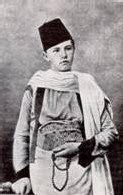Apropos of THE NOMAD, the 70-minute new musical by Elizabeth Swados (music/book/
lyrics) and Erin Courtney (book/lyrics), at the Flea, a few words of introduction might be in order. It's based on the brief but unusual life of Isabelle Eberhardt (1877-1904), born and raised in Switzerland, the daughter of an aristocratic German-Russian mother and an Armenian father, who happened to be both a priest and an anarchist. Well educated and multilingual (six languages), she took an interest in Islamic culture, learned Arabic, and traveled to Algiers with her also unconventional mother in 1897, where both converted to Islam.
 |
| Neil Redfield, Teri Madonna. Photo: Isaiah Tanenbaum. |
Her mother died while they were in North Africa
and her father passed away in Switzerland in 1897, after which Isabelle returned to
Africa, where she took the name Si Mahmoud Essadi, dressed (and was accepted) as
a man (although she was heterosexually promiscuous), adopted a nomad’s life to explore
the Sahara, and lived among the Arabs, smoking kef, drinking extensively,
engaging in mystical Sufi practices, and writing in books and newspapers about
her experiences. She was involved in the French colonial presence in Algeria,
but also supported the oppressed local citizens. She faced many dangers, and nearly
lost an arm to an assassin’s blade. In 1901 she married an Algerian soldier named Slimane
Ehnni and in 1904 she died when her clay home in Algeria was destroyed
in a flash flood. She was only 27.
The drama in the life of such a surprisingly
independent, late 19th-century, cross-dressing woman has not escaped the eye of
film and theatre makers. ISABELLE EBERHARDT, a 1991 movie, starred French
actress Mathilda May (Peter O’Toole was also in it), while British playwright Timberlake
Wertenbaker’s 1981 play NEW ANATOMIES also
examined this iconoclastic woman’s life. There even has been an opera about her, SONG
FROM THE UPROAR: THE LIVES AND DEATHS OF ISABELLE
EBERHARDT (2012).
 |
| Teri Madonna and Ensemble. :Photo: Isaiah Tanenbaum. |
Swados and Courtney have created a
skeletonized telling of Eberhardt’s story, at least 90% of it sung, directed by
Swados with the aid of nicely stylized movement
and choreography by Anj Taj. Members of the Flea’s resident acting company, the
Bats, make up a flexible ensemble of 11, several of them playing named roles; barefoot, they fill
the space in simplified versions of Arab garments, occasionally mixed
with French army uniform elements, while Isabelle is played by Teri
Madonna, with--for some inexplicable reason--her 17-year-old self portrayed by Sydney Blaxill, who often
shadows her older persona. The show commences with Isabelle singing about her
death, so there’s no suspense about the outcome, and then rambles through the
chief moments in her life, none of them creating any sense of a developing
drama.
 |
| Teri Madonna, Sydney Blaxill. Photo: Isaiah Tanenbaum. |
Lydia Fine designed the effectively
simple set (nine vertical strips of lightweight cloth surrounding an open
stage), the costumes, and Isabelle’s horse, consisting of a hand-held
EQUUS-like horse’s head supplemented by additional parts held by ensemble
members to create a full-sized, moving animal, much in the familiar Julie
Taymor mold (or that of a low-rent WAR HORSE). Daisy Long's lighting goes a long way toward bringing the space to colorful life. However, the lyrics have a dull flatness and borderline banality, saying very little that's memorably insightful, while Ms. Swados's music—much of it
seemingly inspired by Arab melodies and rhythms—is only sporadically engaging;
too often, it’s little more than serviceable underpinning to support the expository lyrics. Ms. Madonna, who wears a fez, slacks, and a loosely fitted
shirt, carries a tune but is not an especially gifted singer. She has a
persistently upbeat attitude, which she projects regardless of what’s
happening around her.
Despite the inherent fascination in her story, previous attempts to stage or film Isabelle Eberhardt’s life generally were not well received. THE NOMAD, like its predecessors, informs us of the woman’s existence as a mass of contradictions, and as a gender-bending path breaker, but, beyond that, it fails to create much drama out of her dramatic life.
Despite the inherent fascination in her story, previous attempts to stage or film Isabelle Eberhardt’s life generally were not well received. THE NOMAD, like its predecessors, informs us of the woman’s existence as a mass of contradictions, and as a gender-bending path breaker, but, beyond that, it fails to create much drama out of her dramatic life.




